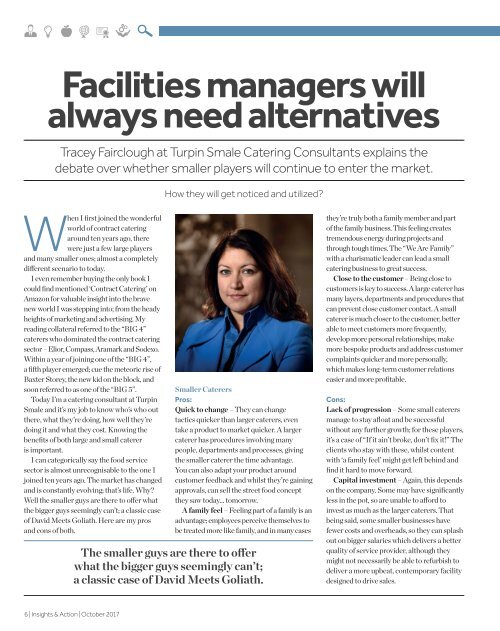EP Insights & Action
Expert observers comment on the Industry. This magazine is designed to bring together the thought leadership, ideas and opinions of leading consultants and operators from across the industry. EP's vision is to create an open narrative and debate that explains the perspective and thinking on the market and Industry. It will help all progress, so let us know your thoughts, subscribe and be involved.
Expert observers comment on the Industry. This magazine is designed to bring together the thought leadership, ideas and opinions of leading consultants and operators from across the industry. EP's vision is to create an open narrative and debate that explains the perspective and thinking on the market and Industry. It will help all progress, so let us know your thoughts, subscribe and be involved.
Create successful ePaper yourself
Turn your PDF publications into a flip-book with our unique Google optimized e-Paper software.
Facilities managers will<br />
always need alternatives<br />
Tracey Fairclough at Turpin Smale Catering Consultants explains the<br />
debate over whether smaller players will continue to enter the market.<br />
How they will get noticed and utilized?<br />
When I first joined the wonderful<br />
world of contract catering<br />
around ten years ago, there<br />
were just a few large players<br />
and many smaller ones; almost a completely<br />
different scenario to today.<br />
I even remember buying the only book I<br />
could find mentioned ‘Contract Catering’ on<br />
Amazon for valuable insight into the brave<br />
new world I was stepping into; from the heady<br />
heights of marketing and advertising. My<br />
reading collateral referred to the “BIG 4”<br />
caterers who dominated the contract catering<br />
sector – Elior, Compass, Aramark and Sodexo.<br />
Within a year of joining one of the “BIG 4”,<br />
a fifth player emerged; cue the meteoric rise of<br />
Baxter Storey, the new kid on the block, and<br />
soon referred to as one of the “BIG 5”.<br />
Today I’m a catering consultant at Turpin<br />
Smale and it’s my job to know who’s who out<br />
there, what they’re doing, how well they’re<br />
doing it and what they cost. Knowing the<br />
benefits of both large and small caterer<br />
is important.<br />
I can categorically say the food service<br />
sector is almost unrecognisable to the one I<br />
joined ten years ago. The market has changed<br />
and is constantly evolving; that’s life. Why?<br />
Well the smaller guys are there to offer what<br />
the bigger guys seemingly can’t; a classic case<br />
of David Meets Goliath. Here are my pros<br />
and cons of both.<br />
Smaller Caterers<br />
Pros:<br />
Quick to change – They can change<br />
tactics quicker than larger caterers, even<br />
take a product to market quicker. A larger<br />
caterer has procedures involving many<br />
people, departments and processes, giving<br />
the smaller caterer the time advantage.<br />
You can also adapt your product around<br />
customer feedback and whilst they’re gaining<br />
approvals, can sell the street food concept<br />
they saw today… tomorrow.<br />
A family feel – Feeling part of a family is an<br />
advantage; employees perceive themselves to<br />
be treated more like family, and in many cases<br />
The smaller guys are there to offer<br />
what the bigger guys seemingly can’t;<br />
a classic case of David Meets Goliath.<br />
they’re truly both a family member and part<br />
of the family business. This feeling creates<br />
tremendous energy during projects and<br />
through tough times. The “We Are Family”<br />
with a charismatic leader can lead a small<br />
catering business to great success.<br />
Close to the customer – Being close to<br />
customers is key to success. A large caterer has<br />
many layers, departments and procedures that<br />
can prevent close customer contact. A small<br />
caterer is much closer to the customer, better<br />
able to meet customers more frequently,<br />
develop more personal relationships, make<br />
more bespoke products and address customer<br />
complaints quicker and more personally,<br />
which makes long-term customer relations<br />
easier and more profitable.<br />
Cons:<br />
Lack of progression – Some small caterers<br />
manage to stay afloat and be successful<br />
without any further growth; for these players,<br />
it’s a case of “If it ain’t broke, don’t fix it!” The<br />
clients who stay with these, whilst content<br />
with ‘a family feel’ might get left behind and<br />
find it hard to move forward.<br />
Capital investment – Again, this depends<br />
on the company. Some may have significantly<br />
less in the pot, so are unable to afford to<br />
invest as much as the larger caterers. That<br />
being said, some smaller businesses have<br />
fewer costs and overheads, so they can splash<br />
out on bigger salaries which delivers a better<br />
quality of service provider, although they<br />
might not necessarily be able to refurbish to<br />
deliver a more upbeat, contemporary facility<br />
designed to drive sales.<br />
6 | <strong>Insights</strong> & <strong>Action</strong> | October 2017
















